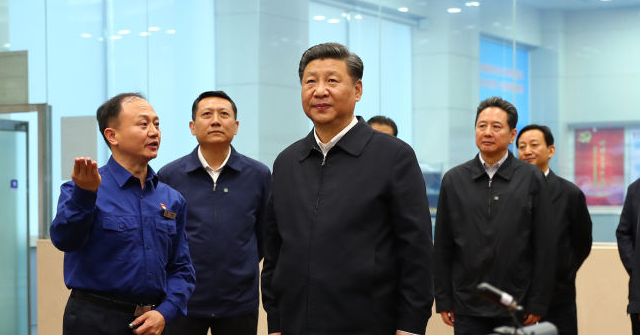A report published on Tuesday by the AidData research lab at William & Mary university in Williamsburg, Virginia, found that the United States is the largest recipient of loans from China.
The report, entitled Chasing China: Learning to Play by Beijing’s Global Lending Rules, found that 1,193 Chinese banks, investment companies, and government institutions loaned $2.2 trillion to recipients in 179 countries between 2000 and 2023.
AidData researchers drew two surprising conclusions from their research: “China’s overseas lending portfolio is vastly larger than previously understood,” and its loans to the developed world are an order of magnitude larger than widely believed.
The common image of Chinese loans is banks pumping huge loans to Third World countries through China’s Belt and Road Initiative (BRI). The ostensible purpose of BRI was to help developing countries build vital infrastructure, but the projects are often criticized as unprofitable “debt traps” approved by spendthrift local governments that saddle the borrowing nations with debts to Beijing they can never repay.
Whatever the flaws of BRI might be, AidData determined that only about 20 percent of China’s titanic lending portfolio involves infrastructure projects in developing nations. Meanwhile, the amount China loans to developed nations “skyrocketed from 12% to 76%” between 2000 and 2023. Ten of the top 20 destinations for Chinese loans are “high-income” countries.
“Another major discovery is that Chinese state-owned creditors have bankrolled approximately 10,000 projects and activities in 72 high-income countries to the tune of nearly $1 trillion,” the report said.
“Much of the lending to wealthy countries is focused on critical infrastructure, critical minerals, and the acquisition of high-tech assets like semiconductor companies,” noted AidData’s lead author, Brad Parks.
China has unquestionably become the largest creditor in the world, and according to AidData’s unexpected findings, the United States is China’s biggest debtor to the tune of $201.83 billion in loans for some 2,500 projects.
“This finding is both unexpected and counterintuitive,” the report noted. “As China’s chief geopolitical rival, the U.S. has spent the better part of the last decade warning other countries of the dangers of accumulating significant debt exposure to China.”
AidData provided a long list of Chinese-funded projects in nearly every state of the union, from liquid natural gas (LNG) projects in Texas and Louisiana to data centers in Northern Virginia an airport terminals at JFK in New York.
“The U.S. recipients of liquidity support from Chinese state-owned creditors — via working capital and revolving credit facilities — include a wide array of Fortune 500 companies, such as Amazon, AT&T, Verizon, Comcast, Tesla, General Motors, Ford, Boeing, Haliburton, Qualcomm, News Corp., and Disney,” the report revealed.
Other “high-income countries” receiving massive Chinese loans included Russia, Venezuela, Argentina, Australia, the United Kingdom, Germany, and Switzerland.
China significantly scaled back lending to the “Global South” developing nations and BRI clients while it was pouring more money into wealthy nations, producing what AidData described as a “myth” that Chinese loans dried up when its economy turned sour. The highly visible and much-discussed loans to developing nations did indeed decline sharply, but much less widely-reported lending to middle- and high-income industrialized countries was booming.
AidData did not paint a rosy picture of China’s lending activities, describing them as secretive and linked to an aggressive geopolitical agenda. A small bit of good news was that China’s loans to American customers seemed mostly driven by good old-fashioned capitalism and the pursuit of profit — the legion of American companies quietly borrowing big money from China turned out to be good bets, and Chinese institutions made a lot of money by lending to them.
The report described China’s lending activities as “opaque and complex,” with very little hard information freely provided by China. Chinese lenders make extensive use of shell companies, overseas affiliates, and “exotic credit instruments” to evade international scrutiny, rendering “a large swathe of its cross-border lending portfolio effectively invisible in reporting systems.”
These tactics also make it difficult for other countries, including the United States, to detect or counter China’s efforts to accumulate controlling positions in sensitive advanced-technology companies.
“A large and growing share of China’s overseas lending portfolio is ‘going dark,’” the report warned.
Beijing releases even less information about the sort of foreign aid and charitable giving that Western nations proudly publicize, but by all indications China has largely abandoned “aid” in favor of loans.
“Beijing is not seeking to burnish its reputation as a global do-gooder,” the authors wrote. “The percentage of its overseas lending and grant-giving portfolio that qualifies as aid plunged from 22% in 2000 to 1% in 2023.”
The report said China is “focused on a different goal,” namely “cementing its position as the international creditor of first — and last — resort that no one can afford to offend or antagonize.”
The gigantic size of its lending operations mean China is not so much breaking the rules of international finance as rewriting them. AidData noted that G7 nations are “making major adjustments that were once inconceivable” to begin playing China’s game, including a shift in emphasis from no-strings-attached foreign aid programs to cross-border lending and partnerships in overseas infrastructure programs.
“Beijing’s go-it-alone approach is no longer a source of scorn, ridicule, or bemusement in Washington, Berlin, London, Tokyo, Paris, Rome, and Ottawa. It has forced G7 policymakers to fundamentally rethink the way they use aid and credit instruments,” the report concluded.
In other words, for the past 20 years, the free world has been practicing socialism — giveaways and welfare programs — while the Chinese Communist Party was practicing flinty-eyed capitalism. The Western world was tossing its taxpayers’ money around, while China was getting signatures on loan paperwork and making profits. The globalists of the 2000s gave China all the money in the world — and they invested it.



